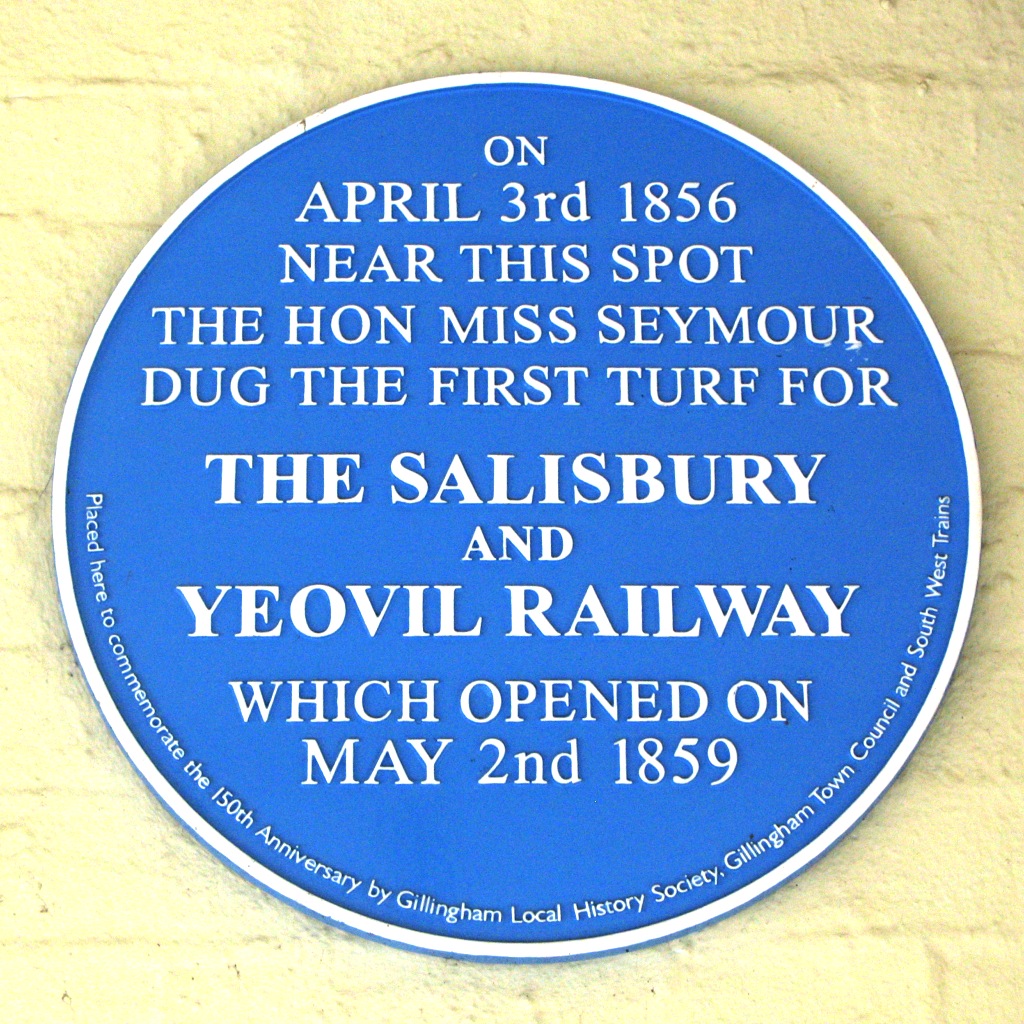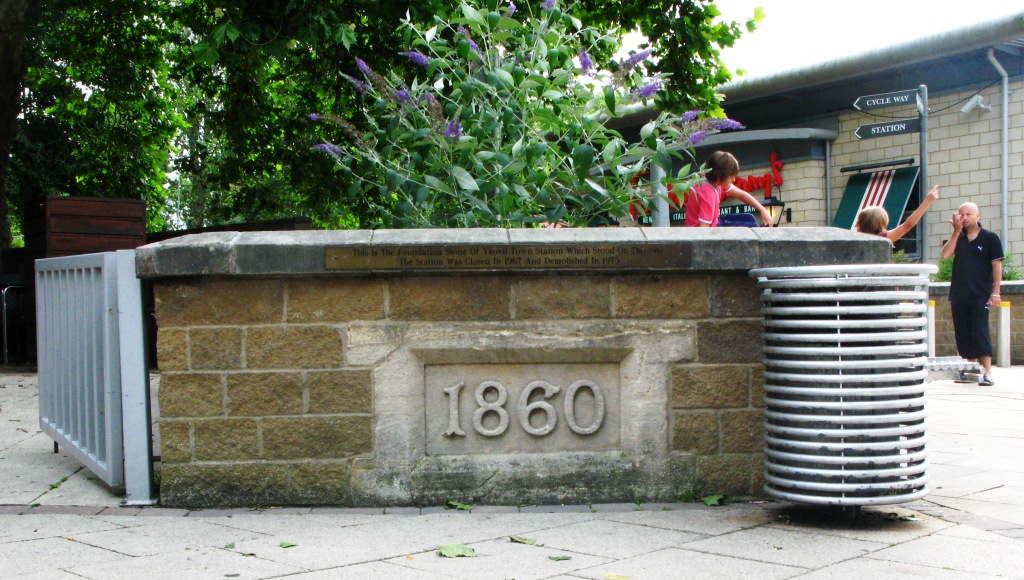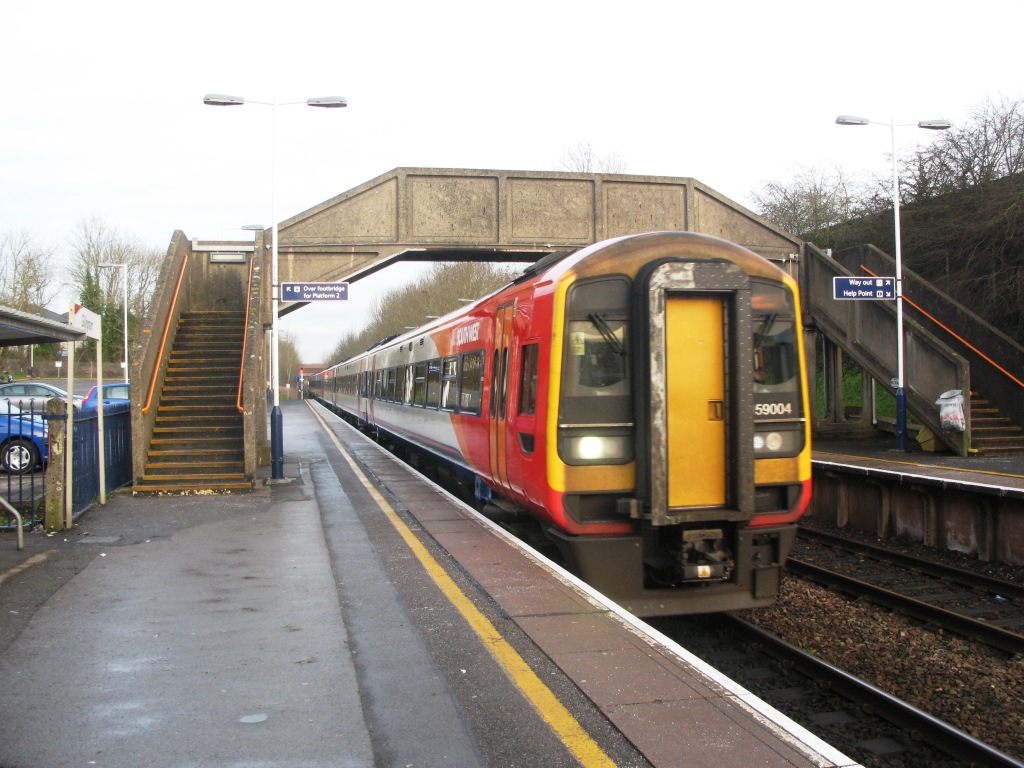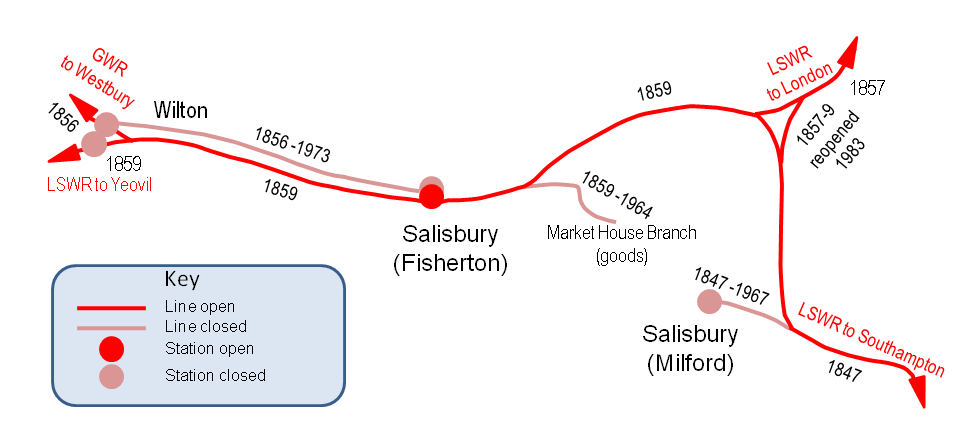|
Salisbury And Yeovil Railway
The Salisbury and Yeovil Railway linked Salisbury (Wiltshire), Gillingham (Dorset) and Yeovil (Somerset) in England. Opened in stages in 1859 and 1860, it formed a bridge route between the main London and South Western Railway (LSWR) network and its lines in Devon and Cornwall. Its trains were operated by the LSWR and it was sold to that company in 1878. Apart from a short section in Yeovil it remains open and carries the London Waterloo to Exeter service of South Western Railway. Despite being founded after the "Railway Mania" of the 1840s, it proved to be one of the most profitable railways in the United Kingdom. This was in part due to carrying all LSWR trains to the south west, and in part due to the very good terms agreed for the LSWR to operate the trains. When the company finally sold out to the LSWR in 1878, it held out for a price which saw the shareholders receive more than the face value of their shares. History The LSWR was completed to Southampton in 1840 and a ... [...More Info...] [...Related Items...] OR: [Wikipedia] [Google] [Baidu] |
London And South Western Railway
The London and South Western Railway (LSWR, sometimes written L&SWR) was a railway company in England from 1838 to 1922. Originating as the London and Southampton Railway, its network extended to Dorchester and Weymouth, to Salisbury, Exeter and Plymouth, and to Padstow, Ilfracombe and Bude. It developed a network of routes in Hampshire, Surrey and Berkshire, including Portsmouth and Reading. The LSWR became famous for its express passenger trains to Bournemouth and Weymouth, and to Devon and Cornwall. Nearer London it developed a dense suburban network and was pioneering in the introduction of a widespread suburban electrified passenger network. It was the prime mover of the development of Southampton Docks, which became an important ocean terminal as well as a harbour for cross channel services and for Isle of Wight ferries. Although the LSWR's area of influence was not the home of large-scale heavy industry, the transport goods and mineral traffic was a major activity, a ... [...More Info...] [...Related Items...] OR: [Wikipedia] [Google] [Baidu] |
Dorchester South Railway Station
Dorchester South railway station is one of two stations serving the town of Dorchester in Dorset, England, the other one being Dorchester West. The station is on the South West Main Line. It is down the line from Railways in the United Kingdom historically are measured in miles and chains. There are 80 chains to one mile. and is situated between and . The station is managed by South Western Railway, who operate all trains serving it. History The station opened on 1 June 1847 when the Southampton and Dorchester Railway was completed. The station was built as an east facing terminus with the intent of continuing the line westwards towards Exeter. These plans were never realised, and instead another line was built from the terminus towards Weymouth. This joined with the Great Western Railway's line (now the Heart of Wessex Line) from Dorchester West and continued as a joint line to Weymouth. Originally named ''Dorchester'', the station was renamed ''Dorchester South'' on ... [...More Info...] [...Related Items...] OR: [Wikipedia] [Google] [Baidu] |
Templecombe Junction Changes
Templecombe is a village in Somerset, England, situated on the A357 road five miles south of Wincanton, east of Yeovil, and west of Salisbury. The village has a population of 1,560. Along with the hamlet of Combe Throop, it forms the parish of Abbas and Templecombe. History Prior to the Norman Conquest Combe was held by Leofwine Godwinson. One part of the village was known as Abbas Combe which was recorded in the ''Domesday Book'' of 1086–7 as ''Cumbe'', when it was held by the church of St Edward, Shaftesbury. The other manor within the parish was held by Godwinson, but after the Norman Conquest, was given to Bishop Odo of Bayeux. It was his descendant Serlo FitzOdo who granted it to the Knights Templar. The parish was part of the Hundred of Horethorne. Templecombe derives its name from ''Combe Templariorum'', after the Knights Templar who established Templecombe Preceptory in the village in 1185. After they were suppressed in 1312 it was granted to the Knights Hospit ... [...More Info...] [...Related Items...] OR: [Wikipedia] [Google] [Baidu] |
Passing Loop
A passing loop (UK usage) or passing siding (North America) (also called a crossing loop, crossing place, refuge loop or, colloquially, a hole) is a place on a single line railway or tramway, often located at or near a station, where trains or trams travelling in opposite directions can pass each other. Trains/trams going in the same direction can also overtake, provided that the signalling arrangement allows it. A passing loop is double-ended and connected to the main track at both ends, though a dead end siding known as a refuge siding, which is much less convenient, can be used. A similar arrangement is used on the gauntlet track of cable railways and funiculars, and in passing places on single-track roads. Ideally, the loop should be longer than all trains needing to cross at that point. Unless the loop is of sufficient length to be dynamic, the first train to arrive must stop or move very slowly, while the second to arrive may pass at speed. If one train is too long for ... [...More Info...] [...Related Items...] OR: [Wikipedia] [Google] [Baidu] |
Exeter Central Railway Station
Exeter Central railway station is the most central of the stations in the city of Exeter, Devon, United Kingdom. It is down the line from . The station is smaller than on the west side of the city. Great Western Railway manages the station and operates most services, as well as South Western Railway. From 1860, when it was opened by the London and South Western Railway, until 1933, when it was rebuilt, it was known as Exeter Queen Street. History The London and South Western Railway (LSWR) opened its Exeter Extension from on 19 July 1860 and its station at Queen Street in the city centre became the terminus for services from London Waterloo station, known as Exeter Queen Street. From 1 May 1861 it was also the terminus for trains on the new Exeter and Exmouth Railway. This was also operated by the LSWR but the physical junction between the two lines was at Exmouth Junction, east of Queen Street. The final piece of the LSWR's network in Exeter was opened on 1 February ... [...More Info...] [...Related Items...] OR: [Wikipedia] [Google] [Baidu] |
Bradford Abbas
Bradford Abbas is a village and civil parish in north west Dorset, England, southeast of Yeovil and southwest of Sherborne. The parish includes the small settlement of Saxon Maybank to the north. In the 2011 census the population of the parish was 975. The name of the village signifies the "Abbot's broad ford" on the River Ivel, the abbot in question being that of Sherborne; the land was given to Sherborne Abbey by King Alfred the Great. In the dry summer of 2010 cropmarks in sun-parched fields of barley, visible from the air, revealed the existence of a previously unsuspected 1st-century temporary Roman camp, one of only four detected in southwest Britain. In the 19th century five Roman kilns were found in a field to the east of the village. Also found at the site were pottery, roof slates, bracelets and quern Quern ( da, Kværn) is a former municipality in the district of Schleswig-Flensburg, in Schleswig-Holstein, Germany Germany,, officially the Federal Re ... [...More Info...] [...Related Items...] OR: [Wikipedia] [Google] [Baidu] |
Yeovil Town Railway Station
Yeovil Town railway station was a railway station serving the town of Yeovil in Somerset, England. The station was on the Yeovil to Taunton Line and also had shuttle services to Pen Mill and Yeovil Junction stations. The station opened on 1 June 1861, replacing an earlier Yeovil Hendford railway station Yeovil ( ) is a town and civil parishes in England, civil parish in the district of South Somerset, England. The population of Yeovil at the last census (2011) was 45,784. More recent estimates show a population of 48,564. It is close to Somer ... when the line was extended. It closed to passenger traffic on 3 October 1966, but freight and parcels traffic continued to use the station until 3 March 1967, when these services were also withdrawn. The site today After closure, the station was demolished and the site was cleared to serve as a car and coach park. A cinema and leisure complex has also been built on part of the site. References Further reading * Bu ... [...More Info...] [...Related Items...] OR: [Wikipedia] [Google] [Baidu] |
Bristol And Exeter Railway
The Bristol & Exeter Railway (B&ER) was an English railway company formed to connect Bristol and Exeter. It was built on the broad gauge and its engineer was Isambard Kingdom Brunel. It opened in stages between 1841 and 1844. It was allied with the Great Western Railway (GWR), which built its main line between London and Bristol, and in time formed part of a through route between London and Cornwall. It became involved in the gauge wars, a protracted and expensive attempt to secure territory against rival companies supported by the London and South Western Railway (LSWR) which used the narrow gauge, later referred to as ''standard gauge''. At first it contracted with the GWR for that company to work the line, avoiding the expense of acquiring locomotives, but after that arrangement expired in 1849, the B&ER operated its own line. It opened a number of branches within the general area it served: to Clevedon, Cheddar, Wells, Weston-super-Mare, Chard, Yeovil and Tiverton. The B ... [...More Info...] [...Related Items...] OR: [Wikipedia] [Google] [Baidu] |
Gillingham (Dorset) Railway Station
Gillingham railway station is in Gillingham, Dorset, England. It is on the West of England Main Line, down the line from . Today it is managed by South Western Railway. The main offices, designed by Sir William Tite, stand on the north side of the line. It is commonly suffixed as ''Gillingham (Dorset)'' to distinguish it from the station of the same name in Kent. History On 3 April 1856 Miss Seymour, sister of the company’s chairman, dug the first ceremonial sod for the Salisbury and Yeovil Railway (S&YR) at Gillingham. Three years later, on 2 May 1859, the railway from opened to Gillingham, and was completed to station at Yeovil on 1 June 1860. The station was close to the town centre. The main offices and goods shed were on the north side of the line, further sidings to serve a brickworks were added on the other side of the line, and a signal box opened in 1875. Trains were provided for the S&YR by the London and South Western Railway (LSWR), which bought out the s ... [...More Info...] [...Related Items...] OR: [Wikipedia] [Google] [Baidu] |
Salisbury Railway Station
Salisbury railway station serves the city of Salisbury in Wiltshire, England. It is from on the West of England line to . This is crossed by the Wessex Main Line from Bristol Temple Meads to Southampton Central. The station is operated and served by South Western Railway (SWR), and is also served by Great Western Railway (GWR). History Three railway station sites have been used in Salisbury, owned by the London and South Western Railway (LSWR) from 1847 and the Great Western Railway (GWR) from 1856, as well as two further stations at Wilton, west. London and South Western Railway The LSWR opened their Milford station on the east side of the city on 1 March 1847, with the opening of their branch line from Eastleigh, near Southampton, to passenger traffic. This was the city's only railway until 30 June 1856, when the GWR opened the Salisbury branch from Westbury. On 1 May 1857, the LSWR opened the extended main line from London and Andover, at first to the Milford stat ... [...More Info...] [...Related Items...] OR: [Wikipedia] [Google] [Baidu] |
Yeovil Railways
Yeovil ( ) is a town and civil parish in the district of South Somerset, England. The population of Yeovil at the last census (2011) was 45,784. More recent estimates show a population of 48,564. It is close to Somerset's southern border with Dorset, from London, south of Bristol, from Sherborne and from Taunton. The aircraft and defence industries which developed in the 20th century made it a target for bombing in the Second World War; they are still major employers. Yeovil Country Park, which includes Ninesprings, is one of several open spaces with educational, cultural and sporting facilities. Religious sites include the 14th-century Church of St John the Baptist. The town is on the A30 and A37 roads and has two railway stations. History Archaeological surveys have yielded Palaeolithic burial and settlement sites mainly to the south of the modern town, particularly in Hendford, where a Bronze Age golden torc (twisted collar) was found. Yeovil is on the main Roman ro ... [...More Info...] [...Related Items...] OR: [Wikipedia] [Google] [Baidu] |
Act Of Parliament
Acts of Parliament, sometimes referred to as primary legislation, are texts of law passed by the Legislature, legislative body of a jurisdiction (often a parliament or council). In most countries with a parliamentary system of government, acts of parliament begin as a Bill (law), bill, which the legislature votes on. Depending on the structure of government, this text may then be subject to assent or approval from the Executive (government), executive branch. Bills A draft act of parliament is known as a Bill (proposed law), bill. In other words, a bill is a proposed law that needs to be discussed in the parliament before it can become a law. In territories with a Westminster system, most bills that have any possibility of becoming law are introduced into parliament by the government. This will usually happen following the publication of a "white paper", setting out the issues and the way in which the proposed new law is intended to deal with them. A bill may also be introduced in ... [...More Info...] [...Related Items...] OR: [Wikipedia] [Google] [Baidu] |


.jpg)





